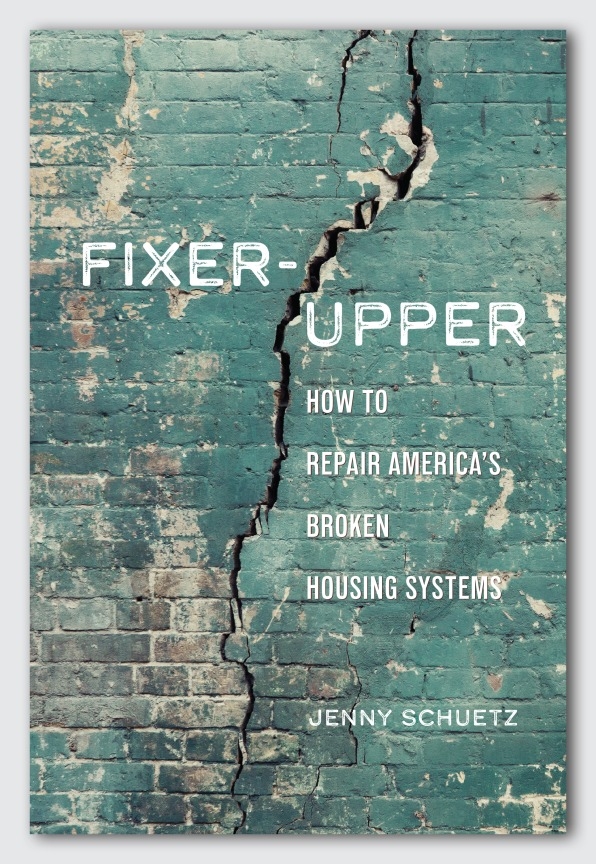In so many ways, the housing market in the U.S. is epically screwed up.
There are the roughly 20 million households spending more than a third of their income on housing. There’s the estimated 6.8 million home shortage in the overall housing stock, an under-supply that reinforces those affordability issues. There are the zoning laws that disallow density in places where demand could easily support it. There are the powerful voices of homeowners pressuring local officials to block affordable housing development. There are the decades-long ramifications of racist housing policies.

Brookings Institution housing expert Jenny Schuetz dives headfirst into this snake pit in her new book Fixer-Upper: How to Repair America’s Broken Housing Systems. As the name suggests, Schuetz knows the breadth of the challenges facing housing in the U.S. She also has an idea for how to solve them: Stop building housing in places it shouldn’t be, and start building more housing where people actually want it.
Stop building in all the wrong places
Too many homes are being built in unsustainable places, argues Schuetz. Climate change is making this all the more clear, “whether that’s the coastline of Florida expecting sea level rise and hurricanes, or wildfire-prone areas in much of the West,” Schuetz says. “We are building homes in places that year after year are hit with climate disasters, the homes are destroyed and get rebuilt in the same place.”
This cycle isn’t sustainable. And yet mechanisms of insurance, government-subsidized infrastructure, and short-sighted land use planning mean that building and rebuilding in these places often happens with little regard for their inherent risks.
“Individual households, developers, and mortgage lenders don’t pay the cost of the climate damage that they’re creating or of the risk that they’re incurring,” says Schuetz. “The cost of all this climate damage from building in the wrong places is spread across a lot of people, including a large chunk that falls on U.S. taxpayers.” A recent report from the Center for American Progress puts this is stark numbers: In 2020, extreme weather events cost U.S. taxpayers an estimated $99 billion.
Government-subsidized disaster recovery becomes a tacit approval for climate-risky homes to be built in places that can be or already have been destroyed by extreme weather events. Home builders and homeowners see that, even if a seemingly unlikely disaster were to strike, public recovery funds would be there to help.
Similar government subsidies also signal to the market that developers can build homes in places where costs and labor are cheaper, but that are just as connected to climate change. Exurban car-oriented development has thrived in the U.S. as a result.
“Some of this is driven by demand for a low-density lifestyle. But it’s also something that we subsidize in some not easy to observe ways,” she says. Development on the suburban fringe is propped up by these subsidies, and encouraged by the suburban municipalities eager for a larger tax base. “The cost of building roads and all the other infrastructure that goes with homes including extension of water and sewers, that’s much more expensive to build out in the exurbs, but that’s not borne by the homeowners or the developers.”
But Schuetz sees some signs that these conditions may change, especially when it comes to places likely to experience a climate-related disaster. That could lead to more people opting not to live in places they probably shouldn’t.
“Because the financial costs of issuing mortgages in these high-risk places is showing up on balance sheets, the finance industry is taking note,” Schuetz says. “In places like California, the private insurance industry is at some point going to just stop insuring homes in places that catch fire every year, and that will make people make some decisions.”
Meet demand where it is
The other side of the coin is that, while it’s easy to build in far-out or risky locations where demand for housing is not naturally high, it’s difficult to build in the kind of in-demand urban areas many people would like to live. This is sometimes an issue of cost–expensive land makes it hard for the financials to work out on all but the most expensive housing. It’s also a matter of how local governments fund themselves. With schools and parks reliant on property taxes, cities have an incentive to approve larger homes that will bring in more tax dollars.
Even more pernicious, Schuetz argues, is the power cities give existing homeowners to veto new development. “We have over the last 30 to 40 years gone to a development process that’s very discretionary,” she says. “Every proposal is evaluated on its merit on a case by case basis.” For homeowners sensitive to any impact on their home values, it’s easy to find an argument against a new affordable housing project or even just slightly higher density.
Schuetz says there are small signs of change that may chip away at this kind of not-in-my-backyard obstructionism. Zoning reform in cities like Minneapolis has made it much easier to get multi-family housing projects approved, and other places are making similar moves. “There’s definitely more political momentum for zoning reform than there’s ever been,” Schuetz says.
States can help this along, she argues, using their power over local governments to set standards for how they manage growth and development. A high profile effort to make such a change narrowly failed in California, but Schuetz says places like Idaho and Virginia may be close to success.
“We don’t need all 50 states to do zoning reform, we need maybe six to eight where this is the biggest problem,” she says. “If a couple of the big states get this right and start making progress, that actually makes a dent in our national housing shortage.”
(29)